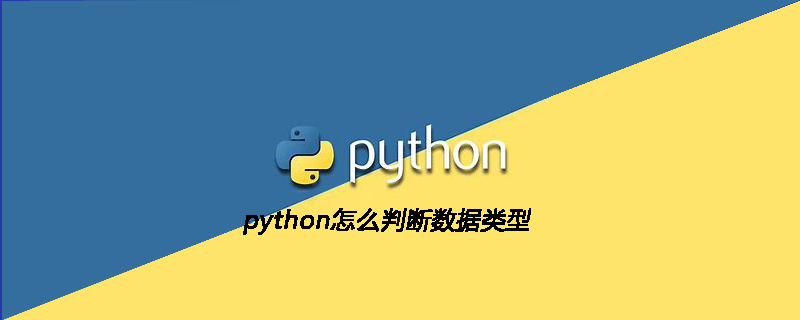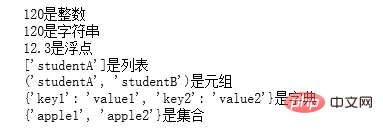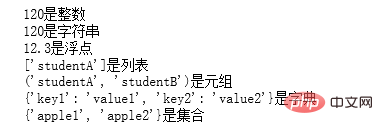

Python のデータ型には、数値 (int)、浮動小数点 (float)、文字列 (str)、リスト (list)、タプル (tuple)、辞書 (dict) が含まれます。 。
一般的には以下の方法で判定されます。
1, isinstance (パラメータ 1, パラメータ 2)
説明: この関数は、インスタンスを判定するために使用されます。変数 (パラメータ 1) 既知の変数タイプかどうか (パラメータ 2) type() と同様
#パラメータ 1: 変数
パラメータ 2: 直接または間接のクラス名にすることができます。基本型、またはそれらから構成されるタプル。
戻り値: オブジェクトの型がパラメーター 2 (classinfo) の型と同じである場合は True を返し、それ以外の場合は False を返します。
関連する推奨事項:「Python ビデオ チュートリアル 」
例:
#判断变量类型的函数
def typeof(variate):
type=None
if isinstance(variate,int):
type = "int"
elif isinstance(variate,str):
type = "str"
elif isinstance(variate,float):
type = "float"
elif isinstance(variate,list):
type = "list"
elif isinstance(variate,tuple):
type = "tuple"
elif isinstance(variate,dict):
type = "dict"
elif isinstance(variate,set):
type = "set"
return type
# 返回变量类型
def getType(variate):
arr = {"int":"整数","float":"浮点","str":"字符串","list":"列表","tuple":"元组","dict":"字典","set":"集合"}
vartype = typeof(variate)
if not (vartype in arr):
return "未知类型"
return arr[vartype]
#判断变量是否为整数
money=120
print("{0}是{1}".format(money,getType(money)))
#判断变量是否为字符串
money="120"
print("{0}是{1}".format(money,getType(money)))
money=12.3
print("{0}是{1}".format(money,getType(money)))
#判断变量是否为列表
students=['studentA']
print("{0}是{1}".format(students,getType(students)))
#判断变量是否为元组
students=('studentA','studentB')
print("{0}是{1}".format(students,getType(students)))
#判断变量是否为字典
dictory={"key1":"value1","key2":"value2"}
print("{0}是{1}".format(dictory,getType(dictory)))
#判断变量是否为集合
apple={"apple1","apple2"}
print("{0}是{1}".format(apple,getType(apple)))Return:

##2. 既知の型の定数と比較する
例:#判断变量类型的函数
def typeof(variate):
type1 = ""
if type(variate) == type(1):
type1 = "int"
elif type(variate) == type("str"):
type1 = "str"
elif type(variate) == type(12.3):
type1 = "float"
elif type(variate) == type([1]):
type1 = "list"
elif type(variate) == type(()):
type1 = "tuple"
elif type(variate) == type({"key1":"123"}):
type1 = "dict"
elif type(variate) == type({"key1"}):
type1 = "set"
return type1
#返回变量类型
def getType(variate):
arr = {"int":"整数","float":"浮点","str":"字符串","list":"列表","tuple":"元组","dict":"字典","set":"集合"}
vartype = typeof(variate)
if not (vartype in arr):
return "未知类型"
return arr[vartype]
#判断变量是否为整数
money=120
print("{0}是{1}".format(money,getType(money)))
#判断变量是否为字符串
money="120"
print("{0}是{1}".format(money,getType(money)))
money=12.3
print("{0}是{1}".format(money,getType(money)))
#判断变量是否为列表
students=['studentA']
print("{0}是{1}".format(students,getType(students)))
#判断变量是否为元组
students=('studentA','studentB')
print("{0}是{1}".format(students,getType(students)))
#判断变量是否为字典
dictory={"key1":"value1","key2":"value2"}
print("{0}是{1}".format(dictory,getType(dictory)))
#判断变量是否为集合
apple={"apple1","apple2"}
print("{0}是{1}".format(apple,getType(apple)))
isinstance() と type() の違い:
type() は、サブクラスを親クラス型とはみなさず、継承関係も考慮しません。 isinstance() は、サブクラスを親クラス型とみなし、継承関係を考慮します。 2 つの型が同じかどうかを確認したい場合は、isinstance() を使用することをお勧めします。以上がPythonでデータ型を判断する方法の詳細内容です。詳細については、PHP 中国語 Web サイトの他の関連記事を参照してください。